Psychology > EXAM > PSYCH - ABNORMAL PSYCHOLOGY THE SCIENCE AND TREATMENT OF PSYCHOLOGICAL DISORDERS 13 TH EDITION KRING (All)
PSYCH - ABNORMAL PSYCHOLOGY THE SCIENCE AND TREATMENT OF PSYCHOLOGICAL DISORDERS 13 TH EDITION KRING Test Bank - Chamberlain College of Nursing
Document Content and Description Below
ABNORMAL PSYCHOLOGY THE SCIENCE AND TREATMENT OF PSYCHOLOGICAL DISORDERS 13 TH EDITION KRING Test Bank Chapter 04: Research Methods in Psychopathology Multiple Choice 1. Science com... es from the Latin word scire, which means 2. a) to know 3. b) to research 4. c) to question 5. d) all of the above Ans: a Type: Factual Section ref: Science and Scientific Methods Difficulty: Easy Learning Objective: Define science and the scientific method. Bloomcode: Knowledge 2. The scientific approach requires that theories be stated 3. a) clearly and precisely 4. b) as questions 5. c) in scientific terms 6. d) without reference to research Ans: a Type: Factual Section ref: Science and Scientific Methods Difficulty: Easy Learning Objective: Define science and the scientific method. Bloomcode: Knowledge 3. When testing a theory, each scientific observation must be 4. a) replaceable. 5. b) replicable. 6. c) unique. 7. d) original. Ans: b Type: Factual Section ref: Science and Scientific Methods Difficulty: Easy Learning Objective: Define science and the scientific method. Bloomcode: Knowledge 4. “The primary problem is an unconscious anger toward his mother.” What makes this statement unscientific? 5. a) It is not reliable. 6. b) It does not make sense. 7. c) It is not theoretical. 8. d) It is not testable. Ans: d Type: Applied Section ref: Science and Scientific Methods Difficulty: Medium Learning Objective: Define science and the scientific method. Bloomcode: Applied 5. A theory 6. a) is derived from hypotheses. 7. b) is the result of long deliberation by a scientist. 8. c) attempts to explain a class of phenomena. 9. d) all of the above. Ans: d Type: Factual Section ref: Science and Scientific Methods Difficulty: Medium Learning Objective: Define science and the scientific method. Bloomcode: Knowledge 6. A good theory should 7. a) be incapable of being proven wrong. 8. b) make sense of obscure phenomena. 9. c) develop directly out of observations. 10. d) explain cause-effect relationships. Ans: d Type: Factual Section ref: Science and Scientific Methods Difficulty: Medium Learning Objective: Define science and the scientific method. Bloomcode: Analysis 7. Which of the following are generated by theories? 8. a) case material 9. b) hypotheses 10. c) statistical significance 11. d) none of the above Ans: b Type: Factual Section ref: Science and Scientific Methods Difficulty: Easy Learning Objective: Define science and the scientific method. Bloomcode: Knowledge 8. Juan wants to do a research study on whether or not studying for a test will improve students’ performance. If he believes it will, what would be his hypothesis? 9. a) Will studying improve test performance? 10. b) Will those who don’t study perform worse than those who do? 11. c) Students who study will perform better on the test. 12. d) All of the above Ans: c Type: Applied Section ref: Science and Scientific Methods Difficulty: Medium Learning Objective: Define science and the scientific method. Bloomcode: Applied 9. Which of the following can disprove but not prove a hypothesis? 10. a) correlation 11. b) case study 12. c) experiment 13. d) questionnaire Ans: b Type: Factual Section ref: Approaches to Research on Psychopathology Difficulty: Medium Learning Objective: Define science and the scientific method. Bloomcode: Analysis 10. Dr. Lee has been treating someone with an unusual combination of symptoms. He notes that there is no published research on such a combination of symptoms, and considers developing a case study. How would Dr. Lee conduct this study? 11. a) Try to find other cases like the one he is treating. 12. b) Gather detailed historical and biographical information on this single individual. 13. c) Examine treatment response using an ABAB design. 14. d) Withhold treatment in an effort to fully understand the significance of symptoms. Ans: b Type: Applied Section ref: Approaches to Research on Psychopathology Difficulty: Medium Learning Objective: Define science and the scientific method. Bloomcode: Applied 11. Which research method would be most useful in generating hypotheses about the cause of a newly discovered, rare abnormality? 12. a) case study 13. b) correlational method 14. c) experimental design 15. d) single-subject ABAB design Ans: a Type: Applied Section ref: Approaches to Research on Psychopathology Difficulty: Medium Learning Objective: Describe the advantages and disadvantages of case studies, correlational designs, and experimental designs. Bloomcode: Analysis 12. Case studies can be effective for which of the following purposes? 13. a) Confirming theoretical propositions. 14. b) Generating research hypotheses. 15. c) Demonstrating universal relationships. 16. d) Showing cause-effect relationships. - - - - - - - - - - - - - - - - - - - - -- - - - - - - - - -- 121. Explain the importance of theory in research on psychopathology. How does theory guide the research process? Discuss, in particular, how theory informs decisions in formulating hypotheses, designing independent variables, and selecting dependent variables. Ans: Section ref: Science and Scientific Methods Learning Objective: Define science and the scientific method. Difficulty: Medium Bloomcode: Analysis 122. Design a study to examine how memories change after a traumatic event. Be sure to identify who the participants in your study should be, and whether you can conduct an experimental or correlational study. Ans: Section ref: Approaches to Research on Psychopathology Learning Objective: Describe the advantages and disadvantages of case studies, correlational designs, and experimental designs. Difficulty: Medium Bloomcode: Applied 123. What is the value of double-blind procedures? What are the limits to this procedure in psychopathology research that does not involve medication? Ans: Section ref: The Experiment Learning Objective: Explain the standards and issues in conducting psychotherapy outcome research. Difficulty: Medium Bloomcode: Analysis 124. Compare the case study with the single-case design. What are the advantages and disadvantages of each design? Ans: Section ref: Approaches to Research on Psychopathology Learning Objective: Describe the advantages and disadvantages of case studies, correlational designs, and experimental designs. Difficulty: Medium Bloomcode: Analysis 125. Which designs would result in a study with high internal validity? Why? Which ones would result in a study with high external validity? Why? How does a scientist decide which type of validity is more important for a particular study? Ans: Section ref: Approaches to Research on Psychopathology Learning Objective: Describe the advantages and disadvantages of case studies, correlational designs, and experimental designs. Difficulty: Hard Bloomcode: Synthesis 126. Design an analogue experiment that could be conducted in order to learn more about an aspect of the human experience that cannot be directly tested. Explain why an analogue experiment is necessary. Be sure to identify your independent and dependent variables and state your experimental hypothesis. Ans: Section ref: The Experiment Learning Objective: Explain the standards and issues in conducting psychotherapy outcome research. Difficulty: Hard Bloomcode: Synthesis 127. What are the advantages and disadvantages of meta-analysis? Ans: Section ref: Integrating the Findings of Multiple Studies Learning Objective: Describe the basic steps in conducting a meta-analysis. Difficulty: Medium Bloomcode: Analysis 128. Describe the major types of research strategies used to study pathology. Evaluate the strengths and weaknesses of these strategies. Ans. Section ref: Approaches to Research on Psychopathology Learning Objective: Describe the advantages and disadvantages of case studies, correlational designs, and experimental designs. Difficulty: Medium Bloomcode: Analysis [Show More]
Last updated: 1 year ago
Preview 1 out of 66 pages
Instant download

Buy this document to get the full access instantly
Instant Download Access after purchase
Add to cartInstant download
Reviews( 0 )
Document information
Connected school, study & course
About the document
Uploaded On
Jul 29, 2020
Number of pages
66
Written in
Additional information
This document has been written for:
Uploaded
Jul 29, 2020
Downloads
0
Views
50


























